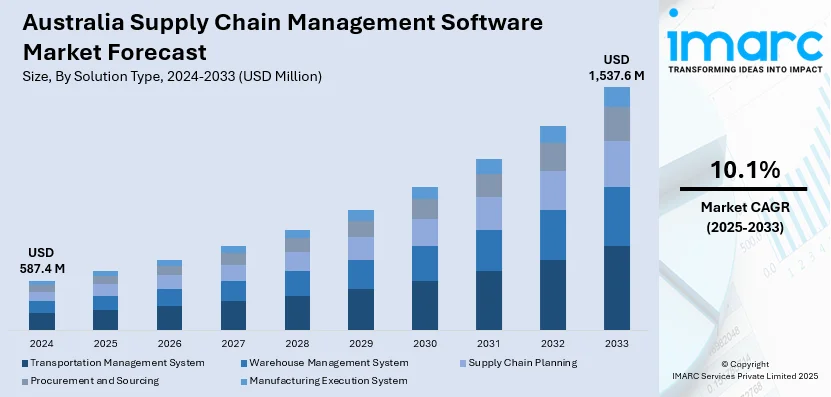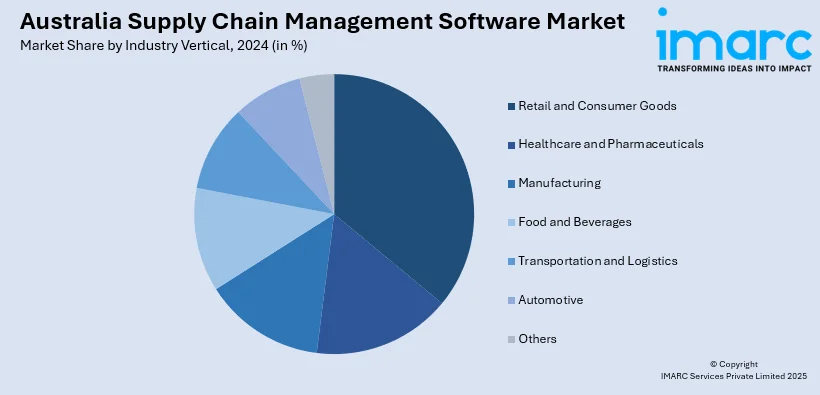
Australia Supply Chain Management Software Market Size, Share, Trends and Forecast by Solution Type, Deployment Mode, Organization Size, Industry Vertical, and Region, 2025-2033
Australia Supply Chain Management Software Market Overview:
The Australia supply chain management software market size reached USD 587.4 Million in 2024. Looking forward, IMARC Group expects the market to reach USD 1,537.6 Million by 2033, exhibiting a growth rate (CAGR) of 10.1% during 2025-2033. The market is witnessing significant growth, driven by increased demand for operational efficiency, real-time tracking, and data-driven insights. In line with this, businesses are adopting advanced solutions to streamline logistics, reduce costs, and improve supply chain visibility, thereby fueling market growth.
|
Report Attribute
|
Key Statistics
|
|---|---|
|
Base Year
|
2024 |
|
Forecast Years
|
2025-2033
|
|
Historical Years
|
2019-2024
|
| Market Size in 2024 | USD 587.4 Million |
| Market Forecast in 2033 | USD 1,537.6 Million |
| Market Growth Rate 2025-2033 | 10.1% |
Australia Supply Chain Management Software Market Trends:
Adoption of AI and Machine Learning
The increasing adoption of AI and Machine Learning in the Australian supply chain management software market is growing at a rapid pace primarily fueled by the requirement for more intelligent data-driven operations. Australia supply chain management software market growth is significantly aided by AI-capabilities that automate key functions such as predictive analytics, demand forecasting, and inventory management. For instance, in February 2024, Palantir Technologies announced its partnership with Coles Supermarkets in Australia to deploy AI-powered tools for workforce strategy and supply chain management across its 850+ stores. This three-year partnership aims to enhance operational efficiency, optimize workforce planning, and improve customer experiences through data integration and real-time decision-making capabilities. These technologies enable companies to reduce inefficiencies, cut costs of operation, and enhance planning precision. Machine learning facilitates systems to learn from past trends and automate recurrent decisions allowing companies to respond quickly to changing markets. Focus on real-time information and adaptive algorithms is strengthening decision-making and supply chain flexibility. As more companies invest in smart automation to remain competitive AI and machine learning are becoming a norm in supply chain platforms. This trend is likely to significantly grow the Australia supply chain management software market share in the future.

To get more information on this market, Request Sample
Rising Demand for Cloud-Based Solutions
Cloud-based solutions are experiencing rapid growth in the Australian supply chain management software market because companies focus on flexibility, accessibility, and scalability. These platforms provide real-time access to data which is essential to handle dynamic supply chains, monitor shipments, handle inventory and respond to disruptions immediately. Cloud deployment minimizes the requirement for massive IT infrastructure and provides simple updates, reduced upfront costs and quicker implementation. In line with this, organizations nowadays are shifting more towards cloud technology to consolidate various supply chain activities such as procurement, logistics, warehousing, and distribution into a single integrated interface. For instance, in January 2025, Complexica Pty Ltd. announced the launch of WaveSCM™ its next-generation cloud-based supply chain management software aimed at rail and intermodal terminals, logistics operators, and more. With enhanced capabilities and a user-friendly design WaveSCM™ integrates extensive operational workflows ensuring efficiency and optimizing supply chain processes for leading logistics companies in Australia. The rise of remote work and decentralized teams has further pushed companies toward cloud-native platforms that ensure secure anywhere-anytime access to critical data. As digital transformation continues across industries cloud adoption is expected to become the default choice. This growing reliance on cloud technologies is shaping a positive Australia supply chain management software market outlook for the coming years.
Australia Supply Chain Management Software Market Segmentation:
IMARC Group provides an analysis of the key trends in each segment of the market, along with forecasts at the regional level for 2025-2033. Our report has categorized the market based on solution type, deployment mode, organization size, and industry vertical.
Solution Type Insights:
- Transportation Management System
- Warehouse Management System
- Supply Chain Planning
- Procurement and Sourcing
- Manufacturing Execution System
The report has provided a detailed breakup and analysis of the market based on the solution type. This includes transportation management system, warehouse management system, supply chain planning, procurement and sourcing, and manufacturing execution system.
Deployment Mode Insights:
- On-premises
- Cloud-based
A detailed breakup and analysis of the market based on the deployment mode have also been provided in the report. This includes on-premises and cloud-based.
Organization Size Insights:
- Small and Medium-sized Enterprises
- Large Enterprises
A detailed breakup and analysis of the market based on the organization size have also been provided in the report. This includes small and medium-sized enterprises, and large enterprises.
Industry Vertical Insights:

- Retail and Consumer Goods
- Healthcare and Pharmaceuticals
- Manufacturing
- Food and Beverages
- Transportation and Logistics
- Automotive
- Others
A detailed breakup and analysis of the market based on the industry vertical have also been provided in the report. This includes retail and consumer goods, healthcare and pharmaceuticals, manufacturing, food and beverages, transportation and logistics, automotive, and others.
Regional Insights:
- Australia Capital Territory & New South Wales
- Victoria & Tasmania
- Queensland
- Northern Territory & Southern Australia
- Western Australia
The report has also provided a comprehensive analysis of all the major regional markets, which include Australia Capital Territory & New South Wales, Victoria & Tasmania, Queensland, Northern Territory & Southern Australia, and Western Australia.
Competitive Landscape:
The market research report has also provided a comprehensive analysis of the competitive landscape. Competitive analysis such as market structure, key player positioning, top winning strategies, competitive dashboard, and company evaluation quadrant has been covered in the report. Also, detailed profiles of all major companies have been provided.
Australia Supply Chain Management Software Market News:
- In July 2024, Queensland announced the launch of Australia’s first battery supply chain database aiding local companies in identifying opportunities and attracting investment. Featuring over 600 entities, the database supports the state’s Battery Industry Strategy, aiming to boost local manufacturing, reduce imports, and create over 9,100 jobs while contributing USD 1.3 Billion to the economy by 2032.
- In May 2024, the Australian Department of Defence announced the launch of a unified supply chain system “JOSCAR” to reduce compliance costs for SMEs. Adapted from a UK program, this initiative allows suppliers to fill out a single questionnaire for multiple contracts improving efficiency and collaboration within the defense sector.
Australia Supply Chain Management Software Market Report Coverage:
| Report Features | Details |
|---|---|
| Base Year of the Analysis | 2024 |
| Historical Period | 2019-2024 |
| Forecast Period | 2025-2033 |
| Units | Million USD |
| Scope of the Report |
Exploration of Historical Trends and Market Outlook, Industry Catalysts and Challenges, Segment-Wise Historical and Future Market Assessment:
|
| Solution Types Covered | Transportation Management System, Warehouse Management System, Supply Chain Planning, Procurement and Sourcing, Manufacturing Execution System |
| Deployment Modes Covered | On-premises, Cloud-based |
| Organization Sizes Covered | Small and Medium-sized Enterprises, Large Enterprises |
| Industry Verticals Covered | Retail and Consumer Goods, Healthcare and Pharmaceuticals, Manufacturing, Food and Beverages, Transportation and Logistics, Automotive, Others |
| Regions Covered | Australia Capital Territory & New South Wales, Victoria & Tasmania, Queensland, Northern Territory & Southern Australia, Western Australia |
| Customization Scope | 10% Free Customization |
| Post-Sale Analyst Support | 10-12 Weeks |
| Delivery Format | PDF and Excel through Email (We can also provide the editable version of the report in PPT/Word format on special request) |
Key Questions Answered in This Report:
- How has the Australia supply chain management software market performed so far and how will it perform in the coming years?
- What is the breakup of the Australia supply chain management software market on the basis of solution type?
- What is the breakup of the Australia supply chain management software market on the basis of deployment mode?
- What is the breakup of the Australia supply chain management software market on the basis of organization size?
- What is the breakup of the Australia supply chain management software market on the basis of industry vertical?
- What is the breakup of the Australia supply chain management software market on the basis of region?
- What are the various stages in the value chain of the Australia supply chain management software market?
- What are the key driving factors and challenges in the Australia supply chain management software market?
- What is the structure of the Australia supply chain management software market and who are the key players?
- What is the degree of competition in the Australia supply chain management software market?
Key Benefits for Stakeholders:
- IMARC’s industry report offers a comprehensive quantitative analysis of various market segments, historical and current market trends, market forecasts, and dynamics of the Australia supply chain management software market from 2019-2033.
- The research report provides the latest information on the market drivers, challenges, and opportunities in the Australia supply chain management software market.
- Porter's five forces analysis assist stakeholders in assessing the impact of new entrants, competitive rivalry, supplier power, buyer power, and the threat of substitution. It helps stakeholders to analyze the level of competition within the Australia supply chain management software industry and its attractiveness.
- Competitive landscape allows stakeholders to understand their competitive environment and provides an insight into the current positions of key players in the market.
Need more help?
- Speak to our experienced analysts for insights on the current market scenarios.
- Include additional segments and countries to customize the report as per your requirement.
- Gain an unparalleled competitive advantage in your domain by understanding how to utilize the report and positively impacting your operations and revenue.
- For further assistance, please connect with our analysts.
 Request Customization
Request Customization
 Speak to an Analyst
Speak to an Analyst
 Request Brochure
Request Brochure
 Inquire Before Buying
Inquire Before Buying




.webp)




.webp)












